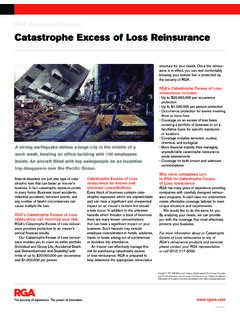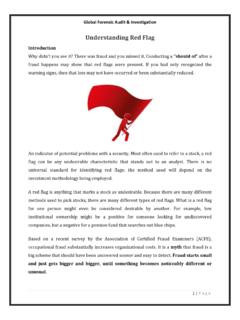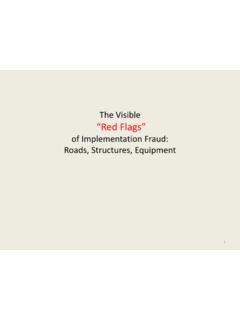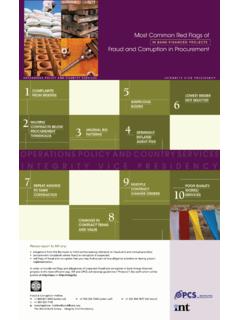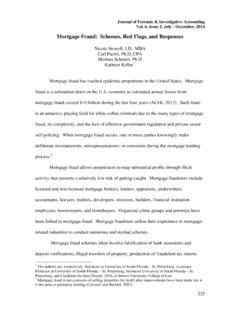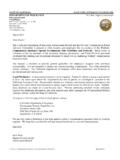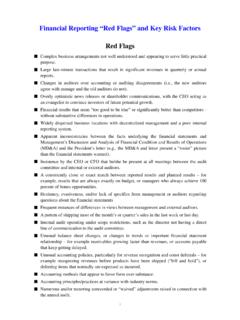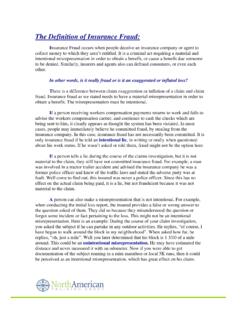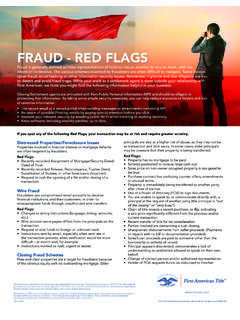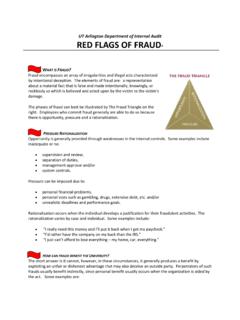Transcription of FRAUD RED FLAGS AND INVESTIGATION TOOLS
1 FRAUD RED FLAGS AND INVESTIGATION TOOLS2 FRAUD RED FLAGS AND INVESTIGATION TOOLSF raud Red FLAGS and INVESTIGATION TOOLS When it comes to FRAUD , it s important to keep your guard up, to watch for common (and not-so-common) signs of FRAUD , and to have TOOLS at your disposal that can help you further investigate any concerns. This packet was developed to be a handy desk-side reference that outlines many known signs of FRAUD and resources for looking more deeply into the case. FRAUD Red FlagsUnderwriting/New Business Signatures on application and paramed exam are not consistent. Inconsistencies in height, weight, physical descriptions, license numbers or Social Security numbers. Blatant material misrepresentation on the application. Employment address is a box. Money order (or other cash equivalent) used to pay initial premium, particularly large single premium. Premiums exceed the client s apparent means. Premium being paid by someone other than the insured or owner.
2 Premiums financed by unapproved premium finance program. Applicant states they do not know how premiums will be paid. Financial information provided on the application is false or cannot be verified. Applications with multiple carriers in short period of time, particularly for large face amounts with ADB. Applicant is a recent arrival to the Applicant resides, works, or spends a great deal of time in a foreign country. Applicant cannot provide driver s license or other identification or has a temporary or recently issued form of identification. Applicant overly interested in claim procedures or is unusually familiar with insurance terminology or procedures. Beneficiary does not have an insurable interest. Owner does not have a relationship to the insured. Initial premium is not valid, , checking account information is not valid, rejected due to insufficient funds, or credit card payment rejected. Pattern of producer closing out cases due for lack of requirements, then immediately submitting a new application on the same individual, particularly when the applications escalate in premium value.
3 Producer submitting multiple applications on the same individual without explanation. Excessive controlled business submitted by producer. Pattern of producer writing identical product, face amount, and application information on multiple applicants (especially for products with limited underwriting requirements).3 FRAUD RED FLAGS AND INVESTIGATION TOOLSI nforce Processing Payments or surrenders via wire transfer from/to foreign parties. Beneficiary changed shortly after issue, particularly to someone with no insurable interest. Ownership changed shortly after issue. Repeated free looks by applicant or excessive number of free looks related to individual agent s block of business. Address changed immediately followed by withdrawal or surrender. Questioned signature on change of ownership, beneficiary, or assignment forms. Questioned signature on withdrawal or cash surrender request. Payee signature forged on check issued to customer.
4 Signatures on reinstatement application inconsistent with other known signatures on file. Credit card or cash equivalent used for reinstatement premium. Reinstatement application backdated. Dollar amount or payee on check issued to customer has been altered. Customer knowingly cashes check after claiming it has been lost and requesting a stop payment and reissue of the check. Misrepresentation as attorney-in-fact under a power of attorney, guardian, or trustee of a minor or incompetent person. Ownership changes to life settlement companies immediately after the policy hits its two-year anniversary. Change in face amount at or near the first policy anniversary. Change to direct bill shortly after issue of a large policy, then no subsequent premium Misappropriation Vendor payment address does not agree with vendor approval application. Spending in excess of budgeted or normal amounts. Weekend or holiday dates on invoices. Submitting fraudulent expense reports (overstated or mischaracterized expenses).
5 Altered or fictitious receipts for expense reports. Submitting fraudulent invoices from vendors. Abuse of corporate credit card. High volume of manual disbursement checks. Excessive number of voided transactions. Discrepancies between bank deposits and postings. Bank accounts not reconciled on a timely basis. Altered payee on legitimate RED FLAGS AND INVESTIGATION TOOLSC ommissions Excessive non-issued cases. High debit commission balance (chargebacks exceed new sales). Low persistency (pattern of early lapses). Undisclosed controlled business. Pattern of early face decreases, particularly at one-year - Death Foreign deaths, especially from less developed or emerging countries. Information concerning foreign travel is incomplete, inconsistent, or vague. Conflicting descriptions of illness or accident. Insured is a homicide victim, and the beneficiary is suspected of involvement in the death. Significant amount of other life insurance, particularly if acquired just prior to death and ADB included.
6 Blatant material misrepresentation on the application. Brief interval between onset of disease and death on a contestable claim. Death occurs shortly after the contestable period has expired. Death occurs shortly after an increase in coverage or reinstatement. Fake death certificate. Absence of verifiable documents, , medical records, police report, coroner s report. Application or payment backdated to precede date of loss. Use of alias or bogus TIN by insured or beneficiary. Insured reported as missing, not deceased. Beneficiary knowingly provides false, incomplete, or misleading information as part of claim submission. Beneficiary changed in close proximity to the date of death. Beneficiary change dated or postmarked after the date of death. Beneficiary change contested before or after date of death. Beneficiary has no insurable interest. Beneficiary is unwilling to provide an authorization or makes alterations to the authorization provided.
7 Beneficiary is unable to produce an original death certificate. Incessant calls from the beneficiary or others regarding the status of the claim. Overly aggressive in attempt for quick payment of claim, threatening to contact insurance commissioner, attorney, or superiors. Unexplained delay in providing notice of death. Beneficiary provides excessive documentation not requested as part of the claim. Age discrepancy on suspected STOLI RED FLAGS AND INVESTIGATION TOOLSC laims - Disability Failure to sign an authorization or altering the authorization provided. Disability coincides with the date of layoff, plant closing, or job termination. Signature of attending physician is similar to the claimant s signature. Claimant provides inconsistent accounts of disability or accident. Claimant frequently cancels medical appointments or refuses to submit to an independent medical examination. Disability stems from subjective complaints such as back pain, strain, headache, depression, or soft tissue injury.
8 Claimant is near retirement age. Length of disability extends normal length of time for that condition. Claim is submitted shortly after contestable period has expired. Difficulty reaching claimant at home or claimant is reached at work while disability is being claimed. Attending physician continually extends disability each time forms are sent. Pressure from claimant for quick decision and immediate threats of complaints to the insurance commissioner, attorney, or superiors. Claimant uses box and refuses to provide a physical address. Claimant is Long-Term CareProvider Provider/PH with same name or address. Billing at the top of the daily limit. Rates change with policy inflation or are unusually high. Paying claims without a break in billing. POC changes result in increased rates for service. Refuses to participate in telephony check-in process. Not available during verification calls. Manual edits to telephony system notes.
9 New/updated documentation shortly after a denial. Revised, copied, whited out, pre- or post-dated Listed as POA/family member. Referred PH to provider. Commits bankers to claim payment by giving inaccurate information. Involved in claim or RED FLAGS AND INVESTIGATION TOOLSP olicy triggers All ADLs are documented as services received: bathing, dressing, toileting, transferring, eating, continence, mobility. ADL assistance does not align with diagnoses/condition. Subjective Maxed policy paying premiums. Chronic illness not likely to improve. New or concurrent condition. Leaves and re-enters the ToolsWhen it comes to preventing FRAUD , information is power. In this age of technology, there are endless ways to find what you are looking for. Some are easily accessible by anyone; others you need to register for or sometimes even pay for. However, a little bit of effort can really help protect your company s bottom line. When you come across one of the red FLAGS mentioned previously, there are resources you can use to help you get the upper hand against the simplest tool is the most helpful.
10 When a red flag goes off, you can use a search engine to view local newspaper sites for obituaries of life insurance claims, search for doctors and specialists to match the information provided by a claimant, search hotels, accident sites or weather conditions to double-check a client s story. Black Book Online is an extremely powerful, free public record search tool. Find information including criminal cases, business ownership records and property ownership data. Zillow is a great web site that will help you to estimate the market value of a proposed insured s home. is a good reference tool that uses publicly available information to determine net worths of high-profile individuals. The FAA s free airman search can help you determine if your applicant is a licensed pilot. The Instant Checkmate Standard Report contains a person s date of birth, home phone numbers, address history, related persons, arrest records, government license information, and social media profiles.
